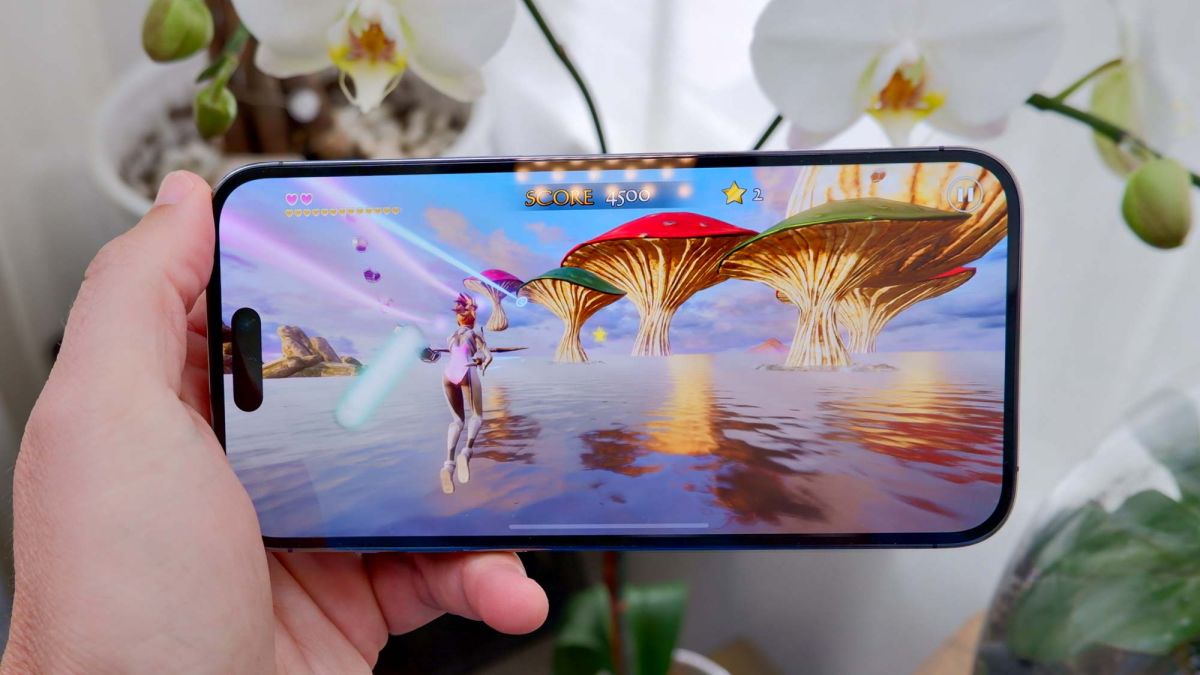Review sản phẩm
iPhone 15 sẽ chạy trên A16 Bionic — ảnh hưởng của điều đó đến hiệu năng thế nào?
Giới thiệu iPhone 15 expected to run on A16 Bionic — how will that affect performance?
iPhone 15 dự kiến sử dụng vi xử lý A16 Bionic – điều này sẽ ảnh hưởng như thế nào đến hiệu suất?
iPhone 15 dự kiến sẽ sử dụng chip A16 Bionic – điều này sẽ ảnh hưởng như thế nào đến hiệu suất?
#iPhone15 #A16Bionic #QueenMobile
Trong thời đại công nghệ ngày càng phát triển, Apple tiếp tục ra mắt những chiếc iPhone với hiệu suất vượt trội và tính năng ấn tượng. Phiên bản iPhone 15 sắp tới được kỳ vọng sẽ sử dụng chip A16 Bionic – một bước tiến đáng kinh ngạc trong lĩnh vực công nghệ di động.
So với tiền nhiệm A15 Bionic, A16 Bionic được cho là mạnh mẽ hơn và mang đến những cải tiến đáng kể về hiệu suất và xử lý đa nhiệm. Chip này dự kiến sẽ sử dụng công nghệ tiến hóa mới nhất, hỗ trợ AI và machine learning, giúp tăng cường khả năng xử lý thông minh và nhanh chóng.
Với việc sử dụng chip A16 Bionic, iPhone 15 sẽ đạt được một hiệu suất tuyệt vời và trải nghiệm người dùng tuyệt hơn. Người dùng có thể mong đợi những trò chơi mượt mà và đồ họa tuyệt đẹp, xem video và làm việc đa nhiệm mà không gặp trở ngại. Đây là một tin vui đối với các game thủ và những người sử dụng yêu thích công nghệ.
Việc sử dụng chip A16 Bionic cũng giúp tăng cường thời lượng pin và hiệu năng sạc nhanh. Người dùng không cần phải lo lắng về việc iPhone 15 sẽ nhanh chóng hết pin hay mất thời gian lâu để sạc đầy. Điều này sẽ mang lại sự tiện ích và thoải mái trong việc sử dụng điện thoại di động hàng ngày.
Đánh giá sản phẩm iPhone 15 với chip A16 Bionic là rất cao, sự kỳ vọng đối với hiệu suất và tính năng của nó cũng rất lớn. Queen Mobile – cửa hàng điện thoại uy tín và chất lượng – là địa chỉ hàng đầu để mua ngay chiếc iPhone 15 với chip A16 Bionic. Bạn sẽ không chỉ sở hữu một sản phẩm tuyệt vời, mà còn nhận được sự tư vấn chuyên nghiệp và dịch vụ hậu mãi tốt nhất.
Hãy đến Queen Mobile ngay hôm nay để trải nghiệm sự mạnh mẽ của iPhone 15 với chip A16 Bionic và khám phá thế giới công nghệ tuyệt vời mà nó mang lại. Bạn sẽ không hối tiếc với quyết định mua hàng tại Queen Mobile!
QUEEN MOBILE chuyên cung cấp điện thoại Iphone, máy tính bảng Ipad, đồng hồ Smartwatch và các phụ kiện APPLE và các giải pháp điện tử và nhà thông minh. Queen Mobile rất hân hạnh được phục vụ quý khách….
_____________________________________________________
Mua #Điện_thoại #iphone #ipad #macbook #samsung #xiaomi #poco #oppo #snapdragon giá tốt, hãy ghé [𝑸𝑼𝑬𝑬𝑵 𝑴𝑶𝑩𝑰𝑳𝑬] ✿ 149 Hòa Bình, phường Hiệp Tân, quận Tân Phú, TP HCM
✿ 402B, Hai Bà Trưng, P Tân Định, Q 1, HCM
✿ 287 đường 3/2 P 10, Q 10, HCM
Hotline (miễn phí) 19003190
Thu cũ đổi mới
Rẻ hơn hoàn tiền
Góp 0%
Thời gian làm việc: 9h – 21h.
KẾT LUẬN
iPhone 15 dự kiến sẽ sử dụng chip A16 Bionic – điều này sẽ ảnh hưởng như thế nào đến hiệu suất của máy? Chip A16 Bionic được cho là sẽ mang lại một đáng kinh ngạc về hiệu năng. Với việc nâng cấp từ chip A15 Bionic, A16 Bionic hứa hẹn sẽ cung cấp khả năng xử lý mạnh mẽ và tăng cường hiệu quả năng lượng. Điều này có nghĩa là người dùng có thể trải nghiệm một trải nghiệm sử dụng mượt mà và nhanh chóng hơn khi sử dụng ứng dụng và chơi game. iPhone 15 cũng được cho là sẽ có màn hình OLED ProMotion 120Hz, camera tiến bộ và một loạt các tính năng mới khác. Không chỉ hứa hẹn mang lại hiệu suất vượt trội, iPhone 15 cũng được kì vọng sẽ là một sản phẩm hấp dẫn và đáng mua cho người tiêu dùng.
Excitement is certainly building about the A17 Bionic, Apple’s latest mobile chip that’s slated to be the driving force in some of this year’s iPhone 15 models. Built on a 3nm processor — the first mobile silicon to make that claim — the A17 promises gains for both performance and power efficiency as a result of its more compact size. Grab an A17-powered iPhone this fall, and you’re more or less assured of having the best-performing phone around.
But what happens if the iPhone 15 model you buy doesn’t have an A17 Bionic inside?
It’s a very really possibility, as Apple now splits which of its phones feature which of its chipsets. Starting with last year’s iPhone 14 release, it’s the Pro models that get the top-of-the-line system-on chip, while the other devices in Apple’s lineup adopt the chipset powering the previous year’s Pro phones.
Apply that approach to the upcoming iPhone 15 release in the fall, and it’s the iPhone 15 Pro and iPhone 15 Pro Max that figure to be the exclusive home for the A17 Bionic. As for the regular iPhone 15 (and the larger iPhone 15 Plus), you can expect an A16 Bionic to run the show. That’s the same chipset that debuted in last year’s iPhone 14 Pro models.
Living with a year-old chipset in a brand new phone sounds like its something iPhone fans are going to have to get used to, as Apple continues to look for ways to make its Pro offerings more appealing. And based on what we know about the A16 Bionic, it looks like anyone who buys an iPhone 15 or iPhone 15 Plus will at least enjoy a top-performing device, even if it’s not the top-performing device.
A16 Bionic benchmarks: What we know
The advantage of Apple sticking with an already-released system-on-chip is that we already have a good idea of how it might perform, based on our iPhone 14 Pro benchmarks. Looking at overall performance, A16-powered iPhones continue to show a lot of muscle, even when compared to phones that came out after last fall’s iPhones.
| Phone | Processor | Geekbench 5 (single core/multicore) |
| iPhone 14 Pro | A16 Bionic | 1891 / 5469 |
| iPhone 14 Pro Max | A16 Bionic | 1882 / 5333 |
| Samsung Galaxy S23 | Snapdragon 8 Gen 2 for Galaxy | 1522 / 4876 |
| Google Pixel 7 | Tensor G2 | 1054 / 3021 |
| OnePlus 11 | Snapdragon 8 Gen 2 | 1166 / 4962 |
| Motorola Razr+ | Snapdragon 8 Plus Gen 1 | 1320 / 4134 |
The Geekbench 5 test that measures general performance showcases the A16’s power. Both the iPhone 14 Pro and iPhone 14 Pro Max turn in the best numbers on the single core and multicore portions of the test, with the Galaxy S23 and OnePlus 11 coming the closest to challenging that dominance. Those two phones use the Snapdragon 8 Gen 2 — Samsung’s phone has an overclocked version of that chipset — but even the leading Android silicon can’t approach the raw performance numbers that the A16 Bionic yields.
| Phone | Processor | Adobe Premiere Rush (Mins:Secs) |
| iPhone 14 Pro | A16 Bionic | 0:26 |
| iPhone 14 Pro Max | A16 Bionic | 0:30 |
| Samsung Galaxy S23 | Snapdragon 8 Gen 2 for Galaxy | 0:39 |
| Google Pixel 7 | Tensor G2 | 0:47 |
| OnePlus 11 | Snapdragon 8 Gen 2 | 1:11 |
| Motorola Razr+ | Snapdragon 8 Plus Gen 1 | 0:44 |
We see that in real-world applications, too, such as when we time how long it takes Adobe Premiere Rush to transcode a short video clip. The iPhone 14 Pro’s 26-second time remains the best, though the Galaxy S23 is able to get within 10 seconds of the iPhone 14 Pro result. Nevertheless, the A16 Bionic is still the top performer here, which should encourage would-be iPhone 15 buyers.
| Phone | Processor | Wild Life Unlimited (fps) |
| iPhone 14 Pro | A16 Bionic | 74.3 |
| iPhone 14 Pro Max | A16 Bionic | 74 |
| Samsung Galaxy S23 | Snapdragon 8 Gen 2 for Galaxy | 87.3 |
| Google Pixel 7 | Tensor G2 | 40.3 |
| OnePlus 11 | Snapdragon 8 Gen 2 | 84.4 |
| Motorola Razr+ | Snapdragon 8 Plus Gen 1 | 66.8 |
If there’s any area of concern for the iPhone 15, it’s the graphics performance produced by the A16 chipset. It’s not that the numbers are bad — posting upward of 74 frames per second on 3DMark’s Wild Life Unlimited test is a very good result. But the numbers for Snapdragon 8 Gen 2-powered devices are even better, and the results from the Motorola Razr+, which is running on older Snapdragon silicon, isn’t that far off the pace.
Looking at those benchmarks, you’d be concerned that an iPhone 15 running on the A16 Bionic would have a hard time topping some of the best-performing Android phones. And with the Snapdragon 8 Gen 3 likely to appear before the end of the year, upcoming Android devices could narrow the performance gap in areas where the A16 currently reigns supreme. That’s less of a concern for the A17 Bionic-powered devices Apple’s likely to release in September.
An optimized A16 Bionic?

There’s one other question looming over the iPhone 15 launch: Will the A16 Bionic powering the new phones be the same as the one in last year’s iPhone 14 Pro models?
After all, that wasn’t the case with the iPhone 14. Yes, it runs on an A15 Bionic just like the iPhone 13 phones did. But tbe newer models used a chipset with an extra graphics core, and that gave the iPhone 14 a slight boost over its predecessor, even though they both featured the same type of silicon.
In our iPhone 14 benchmarks, the newer phone posted gains of 2% and 8% over the respective Geekbench single and multicore results produced by the iPhone 13. Those aren’t huge gains, obviously, but they do reflect some effort to differentiate performance year-over-year. On the Wild Life Unlimited graphics test, the iPhone 14 saw a 15% improvement in frames per second numbers compared to the iPhone 13.
We haven’t heard whether Apple plans to pull off a similar move with the A16 Bionic chipset slated for the iPhone 15. But if it does manage to tweak performance in some way, that would address the concerns with how well an older chip inside a new iPhone can stand up to the improved silicon that’s likely to power next year’s Android flagships.
A16 Bionic iPhone 15 outlook
As our iPhone 15 vs. iPhone 15 Pro comparison indicates, there are going to be plenty of reasons to opt for Apple’s more premium phones, and the new A17 Bionic chip is going to be one of those. But if your budget does limit you to the standard iPhone 15 model, you can be assured that your phone will deliver strong performance, even if the Pro models have a lot more muscle under the hood.
More from Tom’s Guide



